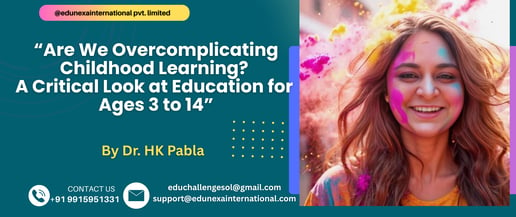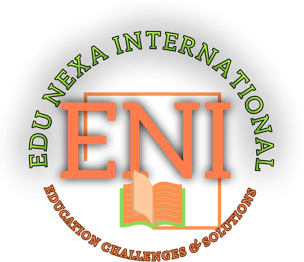“Are We Overcomplicating Childhood Learning? A Critical Look at Education for Ages 3 to 14”
"Explore how modern education burdens children with complexity. Dr. HK Pabla advocates for curiosity-driven, emotionally intelligent learning for ages 3–14."
PURPOSEFUL LEARNING
“Are We Overcomplicating Childhood Learning? A Critical Look at Education for Ages 3 to 14”
Dr. Harvinder Kaur Pabla | Founder & Director, Edu Nexa International | Education Business Strategist | STEM, SEEL & Neuro-Emotional Intelligence Thought Leader | Cross-Subject Curriculum Expert
When Did Childhood Learning Lose Its Natural Flow?
In a world racing toward academic milestones and global benchmarks, we must pause and ask:
Have we turned childhood learning into an intricate maze of expectations, leaving the joy of learning stranded at the gates? Education for ages 3 to 14 should be simple, organic, and alive with wonder. Classrooms often contain complex frameworks, rigid assessments, and premature intellectual demands. The child's natural rhythm can be overshadowed by curriculum checklists and performance metrics.Are we truly educating children—or unintentionally burdening them?
The Illusion of Advancement: When More Means Less
Modern education often equates complexity with progress. More subjects. More modules. More competitions. But beneath this abundance lies a silent void that is the absence of meaning, joy, and emotional connection. Where childhood once unfolded through stories, outdoor play, and unhurried exploration, it now collapses under: Different modules in kindergarten, Language benchmarks in early primary, Leadership camps before age ten. In our race to raise “future-ready” children, are we raising anxious, disconnected learners who have forgotten how to enjoy learning?
Fragmented Learning, Forgotten Wholeness
Today’s curriculum fragments the child’s world into disconnected silos:
Emotional intelligence is taught as a separate subject from science.
Creativity is viewed as distinct from mathematics.
Cultural wisdom is often overlooked due to a focus on coding drills.
But children don’t learn in fragments. Their curiosity is whole, integrated, and interdisciplinary. We must ask:
Are we nurturing the child's holistic growth,
Or
simply building academic silos that impress adults but fail children?
Curriculum Fatigue: Chasing Outcomes, Losing Purpose
The race for academic achievement leads to overload:
8-year-olds grappling with concepts that confuse, not inspire.
10-year-olds preparing for Olympiads instead of chasing butterflies.
14-year-olds are burning out before they discover their passions.
We are designing childhood for efficiency, not for joy.
But children are not projects to be optimized. They are lives to be nurtured.
Emotional Disconnect: The Unheard Questions of the Learner
The most overlooked question in education today is:
“Does this learning touch the child’s heart?”
In our rush to cover content, how often do we stop to ask:
— Does this excite the child’s imagination?
— Does this build emotional resilience?
— Does this help the child feel seen, heard, and valued?
Without emotional resonance, learning becomes mechanical.
It may inform the mind—but it leaves the soul untouched.
The Technology Conundrum: Integration or Intrusion?
Technology isn’t the enemy—misalignment is.
A coding app for a six-year-old may build familiarity, but without emotional relevance, it becomes an empty skill. Truelearning marries tools with purpose, skills with empathy, and innovation with meaning.
The Industry’s Oversight: Packaging Learning as a Product
Education today risks becoming an industry of deliverables, kits, and dashboards.
But children are not consumers of learning products. They are explorers of life. The industry must shift from content overload to meaningful engagement.
Reclaiming the Lost Simplicity: Pathways for Change
1. Curiosity-Driven Learning: From Answers to Questions
Let learning begin where the child’s wonder sparks, not where the adult’s checklist ends.
Instead of designing lessons solely around set outcomes, create spaces where children's questions spark exploration.
A curriculum that follows curiosity leads to deeper engagement, critical thinking, and emotional ownership of learning.
Encouraging children to ask why, how, and what if nurtures thinkers, not just followers.
2. Deep, Not Wide Curriculum: Meaningful Learning Over Measured Coverage
Today’s education often tries to teach too much, too fast, and too soon.
But learning is not a race to cover content; it is a journey to uncover meaning.
By focusing on fewer topics and exploring them through dialogue, projects, and real-life connections, we invite children to build true mastery— Mastery that lingers beyond the classroom, shapes their way of thinking and applies to life itself. Let’s replace superficial coverage with meaningful encounters with knowledge.
3. Rhythm-Aligned Pedagogy: Teaching at the Speed of the Child’s Heart and Mind
Children are not machines built for academic speed—they are souls evolving in rhythm with their emotional, cognitive, and social growth.
When we teach ahead of their readiness, we create confusion. When we teach in tune with their curiosity and capacity, we create confidence. Rhythm-aligned pedagogy means listening to the child’s developmental needs, cultural contexts, and emotional states— not blindly following the timelines of global academic trends or market-driven learning races.
It is education that feels natural, nurturing, and nourishing, rather than pressured, premature, and punishing
4. Restore Wonder and Play: Rekindling the Spirit of Joyful Discovery.
Play is not a break from learning; it is learning in its purest and most joyful form. In the rush to structure every hour of the school day, we have pushed unstructured exploration—the birthplace of creativity and resilience—to the margins.
Restore Wonder and Play: Creating Space for the Unscripted Joy of Learning
Children need space where they are free to build and break, imagine and reinvent, wonder and wander—all without the constant weight of objectives and measurable outcomes.
Whether they are chasing butterflies in a sunlit field, crafting imaginary worlds from cardboard and crayons, or asking questions that have no ready answers—
These moments of unstructured discovery nurture:
— curiosity without fear,
— problem-solving without pressure, and
— relationships without rivalry.
Such play is not a pause from learning—it is learning in its most natural, vibrant form.
A truly balanced learning environment honours both the intentional structure of lessons and the spontaneous magic of exploration,creating learners who are not merely informed by knowledge, but inspired by wonder. In reclaiming play, we restore the joy of learning that lasts far beyond the classroom walls— A joy that builds curious thinkers, creators who are bold, and human beings who are whole
5.Whole-Child Integration: Learning That Nurtures Minds, Hearts, and Hands
Whole-Child Integration: Cultivating the Complete Human Being
Authentic education is not confined to academic scores or subject mastery.
It reaches beyond knowledge to shape the kind of human being a child becomes.
If we teach only the mind, we produce competent individuals—skilled but disconnected.
If we nurture the heart and hands alongside the mind, we cultivate compassionate, capable human beings—anchored in empathy, creativity, and ethical wisdom. True whole-child learning is an intentional fusion of disciplines and dimensions, where:
Emotional wisdom flows hand-in-hand with intellectual growth,
Cultural narratives breathe life into scientific reasoning,
Creative expression enhances mathematical clarity.
It recognizes the child not as a fragmented learner of subjects, but as an evolving whole—
➤ a thinker,
➤ a feeler,
➤ a creator,
➤ and a compassionate citizen of an interconnected world.
Such education does not ask only, “What can this child achieve?” It dares to ask, “Who is this child becoming—and how can learning help them live meaningfully in the world?”Let’s stop asking, “How well do they score?” and start asking, “How fully are they growing?”
A Call to the Education Sector: Simplify to Amplify
Let’s stop asking, “What else can we add to the curriculum?” and start asking, “What no longer serves the child’s joy of learning?” True innovation lies not in adding complexity, but in removing what suffocates natural learning.
Conclusion: Beyond Complexity Lies the Child’s True Voice
Ultimately, it is not the complexity of our curriculum, but the clarity of our purpose, that shapes a child’s learning journey. The question is no longer, “Are our children learning enough?” The real question is, “Are we giving them space to learn what truly matters?” When we silence the noise of complexity, we finally hear what was there all along the quiet, powerful curiosity of the child.
Let’s Reflect Together:
1. What’s one outdated practice you think we should eliminate from childhood education?
How can we make learning joyful again without compromising growth
2. What’s the biggest curriculum complexity you’ve faced—and how did you simplify it?
#EducationLeadership #PurposefulLearning #CurriculumReform #ChildCentricEducation #FutureOfLearning #LearningWithHeart #SocialEmotionalLearning #EduNexaInsights #NeuroEmotionalIntelligence #JoyfulLearning
© 2025 Edu Nexa International Pvt. Ltd. SEEL™, STEM Without Labs™, and Neuro-Emotional Intelligence™ are proprietary learning frameworks of Edu Nexa International. Unauthorized use or reproduction is strictly prohibited. For permissions and collaborations, write to: educhallengesol@gmail.com


